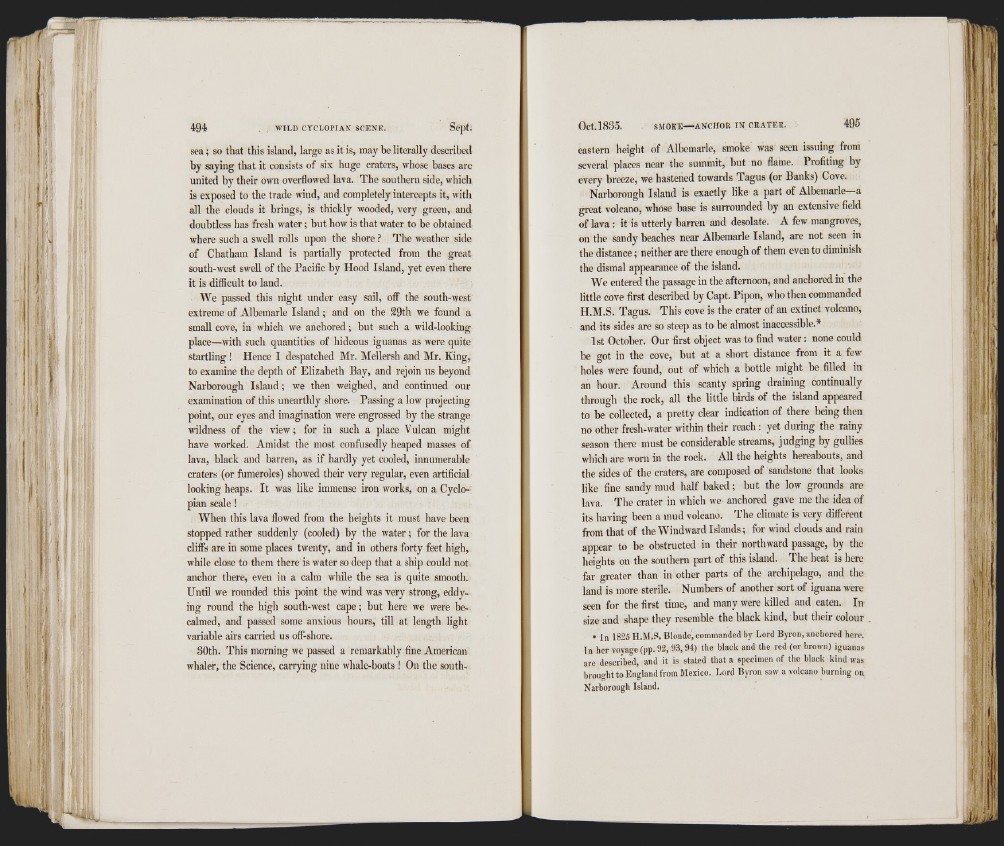
' Í j
■J. :
)'■
11.0
jl'i
!
Ml
1 f" i
iá i
WILD CYCLOPIAN SCENE.
sea ; so that this island, large as it is, may be literally described
by saying that it consists of six huge craters, whose bases are
united by their own overflowed lava. The southern side, which
is exposed to the trade wind, and completely intercepts it, with
all the clouds it brings, is thickly wooded, very green, and
doubtless has fresh water; but how is that water to be obtained
where such a swell rolls upon the shore ? The weather side
of Chatham Island is partially protected from the great
south-west swell of the Pacific by Hood Island, yet even there
it is difficult to land.
We passed this night under easy sail, off the south-west
extreme of Albemarle Island ; and on the 29th we found a
small cove, in which we anchored; but such a wild-looking
place—with such quantities of hideous iguanas as were quite
startling ! Hence I despatched Mr. Mellersh and Mr. King,
to examine the depth of Elizabeth Bay, and rejoin us beyond
Narborough Island; we then weighed, and continued our
examination of this unearthly shore. Passing a low projecting
point, our eyes and imagination were engrossed by the strange
wildness of the view; for in such a place Vulcan might
have worked. Amidst the most confusedly heaped masses of
lava, black and barren, as if hardly yet cooled, innumerable
craters (or fumeroles) showed their very regular, even artificial
looking heaps. It was like immense iron works, on a Cyclopian
scale !
When this lava flowed from the heights it must have been
stopped rather suddenly (cooled) by the water; for the lava
cliffs are in some places twenty, and in others forty feet high,
while close to them there is water so deep that a ship could not
anchor there, even in a calm while the sea is quite smooth.
Until we rounded this point the wind was very strong, eddying
round the high south-west cape; hut here we were becalmed,
and passed some anxious hours, till at length light
variable airs carried us off-shore.
SOth. This morning we passed a remarkably fine American
whaler, the Science, carrying nine whale-boats ! On the southeastern
height of Albemarle, smoke was seen issuing from
several places near the summit, but no flame. Profiting by
every breeze, we hastened towards Tagus (or Banks) Cove.
Narborough Island is exactly like a part of Albemarle a
great volcano, whose base is surrounded by an extensive field
of lava ; it is utterly barren and desolate. A few mangroves,
on the sandy beaches near Albemarle Island, are not seen in
the distance; neither are there enough of them even to diminish
the dismal appearance of the island.
We entered the passage in the afternoon, and anchored in the
little cove first described by Capt. Pipon, who then commanded
H.M.S. Tagus. This cove is the crater of an extinct volcano,
and its sides are so steep as to be almost inaccessible.*
1st October. Our first object was to find water : none could
be got in the cove, but at a short distance from it a few
holes were found, out of which a bottle might be filled in
an hour. Around this scanty spring draining continually
through the rock, all the little birds of the island appeared
to be collected, a pretty clear indication of there being then
no other fresh-water within their reach : yet during the rainy
season there must be considerable streams, judging by gullies
which are worn in the rock. All the heights hereabouts, and
the sides of the craters, are composed of sandstone that looks
like fine sandy mud half baked ; but the low grounds are
lava. The crater in which we anchored gave me the idea of
its having been a mud volcano. The climate is very different
from that of the Windward Islands; for wind clouds and rain
appear to be obstructed in their northward passage, by the
heio-hts on the southern part of this island. The heat is here
far”greater than in other parts of the archipelago, and the
land is more sterile. Numbers of another sort of iguana were
seen for the first time, and many were killed and eaten. In
size and shape they resemble the black kind, but their colour
• In 1825 H.M.S. Blonde, commanded by Lord Byron, anchored here.
In her voyage (pp. 92, 93, 94) the black and the red (or brown) iguanas
are described, and it is stated that a specimen of the black kind was
brought to England from Mexico. Lord Byron saw a volcano burning on
Narborough Island.
i i
ri
f